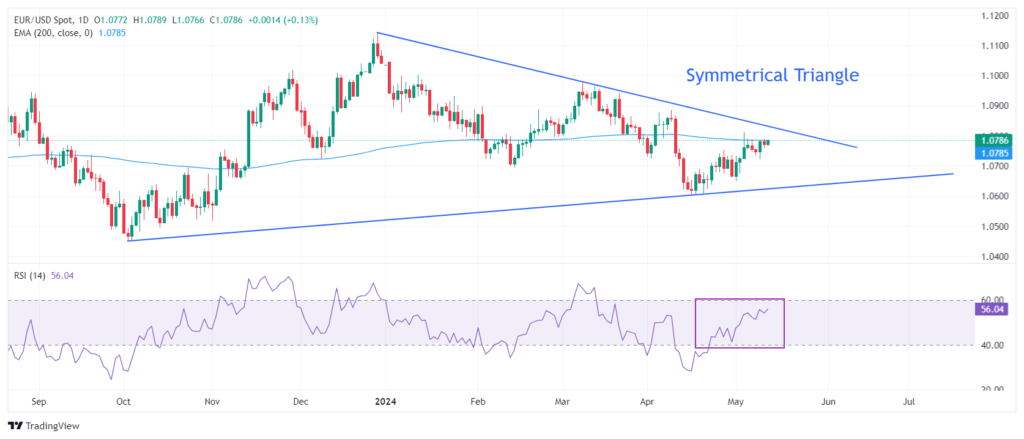- EUR/USD moves higher to 1.0800 as the appeal for risky assets improves.
- The ECB is expected to start reducing interest rates in June.
- Investors keenly await the US inflation data for fresh guidance on the Fed’s interest rates.
During Monday’s American trading session, the EUR/USD exchange rate climbed to 1.0800, buoyed by positive market sentiment. This rise reflects traders’ expectations that the European Central Bank (ECB) will begin cutting interest rates earlier and more aggressively than the Federal Reserve (Fed). The markets anticipate a total reduction of 70 basis points (bps) in ECB rates starting from June this year.
Conversely, the Fed is projected to start reducing rates in September, with a forecast decrease of 45 bps by the end of the year.
This week, the focus will be on the preliminary GDP data for the first quarter from the Eurozone, set to be released on Wednesday. Eurostat is expected to report a steady economic growth of 0.3% quarterly and 0.4% annually. This data will likely provide new insights into the economic outlook of the Eurozone. Additionally, the U.S. Consumer Price Index (CPI) for April, also due on Wednesday, will influence the EUR/USD dynamics.
Market sentiment remains positive, as reflected in the S&P 500’s opening gains. Investors seem to be looking past uncertainties ahead of the upcoming U.S. CPI release. Predictions suggest a slight decline in annual headline inflation to 3.4% in April, down from 3.5% in March. The core CPI, which excludes volatile food and energy prices, is also expected to have slowed to 3.6% annually, from 3.8% previously. Both monthly headline and core inflation rates are anticipated to have decreased to 0.3% from 0.4%.
These inflation figures are crucial as they will shape market expectations regarding the Fed’s upcoming decisions on interest rates. According to the CME FedEWatch tool, there is a 61% likelihood that rates will be reduced from their current range of 5.25%-5.50%.
Before the CPI data, attention will turn to the U.S. Producer Price Index (PPI) for April, to be published on Tuesday. This data will indicate if business owners have increased or decreased the prices of goods and services.
Finally, the U.S. Dollar Index (DXY), which measures the U.S. dollar against six major currencies, dropped significantly to 105.30 in Monday’s session. This decline was influenced by the previous week’s increase in Initial Jobless Claims, which weakened confidence in the strength of the U.S. labor market.
Technical Analysis: EUR/USD plays with 200-DEMA

The EUR/USD exchange rate has rebounded from its decline on Friday, climbing to 1.0800. This level is near the 200-day Exponential Moving Average (EMA), which currently stands at approximately 1.0780. The currency pair is approaching the descending boundary of a Symmetrical Triangle pattern on the daily chart, starting from the high of 1.1140 on December 28. The ascending boundary of this pattern begins from the low of 1.0448 on October 3. This formation indicates a significant decrease in market volatility.
Additionally, the 14-period Relative Strength Index (RSI) is fluctuating between 40.00 and 60.00, reflecting a lack of clear direction from traders.
